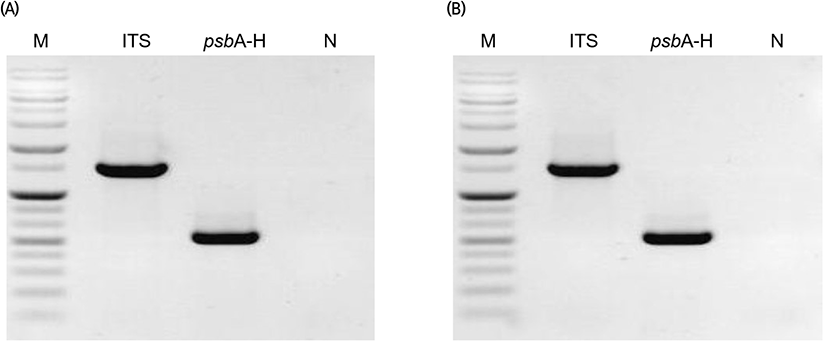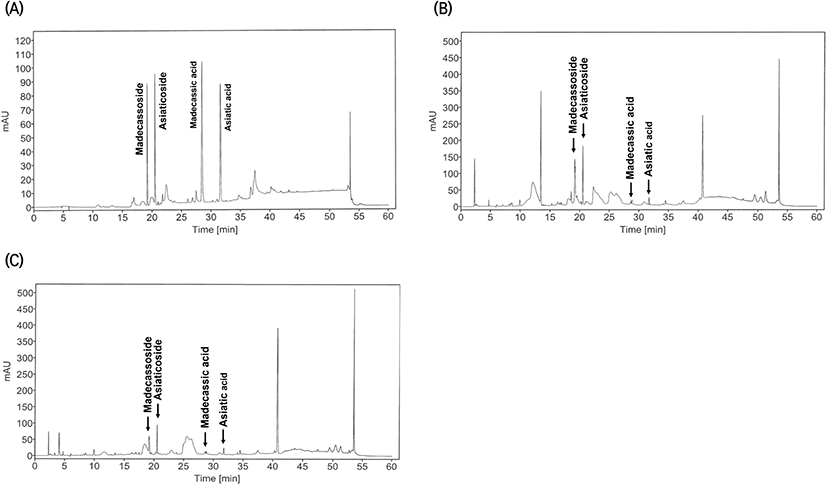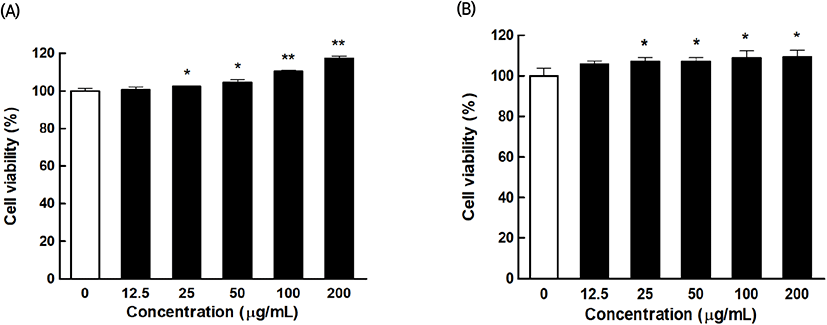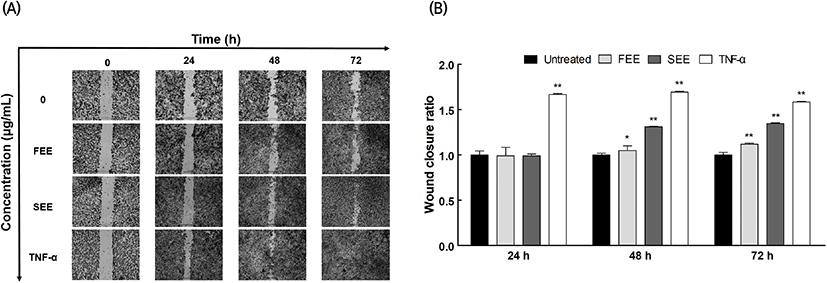1. 서론
병풀[Centella aisatica (L.) Urb.]은 미나리과의 다년생 초본식물로서 생육 특성으로 인해 아프리카, 인도양, 인도 등 고온 다습한 곳에 분포하며, 국내에서는 제주도를 비롯한 남부지방 일부에서만 자생하는 것으로 보고된다(Gohil 등, 2010). 인도 및 아시아 지역에서 전통적으로 약용식물로 사용되고 있는 병풀은 항산화 활성을 비롯하여 항균활성, 면역 활성, 항암 활성 등의 효능이 보고되었다(Harun 등, 2019; Omar 등, 2019). 병풀에는 flavonoid, phenolic acid, triterpene 등의 성분이 존재하며, 그중에서도 madecassoside, asiaticoside, madecassic acid, asiatic acid를 포함한 triterpene이 주요 기능성 물질이다(Hashim 등, 2011; Seong 등, 2020). 특히, 병풀의 triterpene은 콜라겐 형성, 항산화 활성, 피부 노화 억제, 상처 치유 등 피부 개선에 도움이 되는 것으로 알려져 있다(Lee 등, 2019). 다양한 생리활성을 가진 병풀은 의약품, 식품, 화장품 등의 소재로서 매년 수요가 증가하고 있으며, 최근 경남 합천과 충북 충주에서도 병풀을 상업적으로 재배하고 있다(Oh 등, 2021). 하지만, 증가하는 수요에 비해 공급이 적고 제주도, 합천, 충주 등 국내 일부 지역에서 제한적으로 서식하여 대부분 수입에 의존하는 실정이다(Choi 등, 2021; Ha 등, 2009; Shin 등, 2020). 따라서, 병풀 수요를 충족하기 위해 국내에서 안정적으로 재배할 수 있는 기술 발굴이 매우 필요하다.
스마트팜은 4차 산업 혁명 기술인 IoT, 빅데이터, 인공지능 등을 접목하여 작물의 생육환경을 원격으로 유지 및 관리하는 자동화 시스템으로서, 농업 인구 고령화로 인한 농업 인구 감소에 대응할 수 있는 새로운 농업 기술이다(Yeo 등, 2016). 농림축산식품부의 자료에 따르면 스마트팜 도입 후 평균 생산량과 1인당 생산량은 각각 27.9%, 40.4% 향상된 반면 고용 노동비와 병해충 및 질병은 각각 15.9%, 53.7% 감소하였다(Lee과 Seol, 2019). 이와 같이 스마트팜을 도입하면 기존 농업과 비교하여 최소의 인력과 자본으로 고품질의 작물을 생산할 수 있어 국내 농업 기술 경쟁력을 가질 수 있다(Kim 등, 2020).
본 연구에서는 국내 자생 병풀을 스마트팜 및 노지에서 재배한 후 주요 성분과 창상 치유 효능을 비교하여 건강기능식품 소재로서 가능성을 검토하고자 하였다.
2. 재료 및 방법
병풀은 양주, 합천, 제주에서 각각 자생하는 종을 수집하여, 자묘 수 및 엽장, 엽폭, 엽수를 확인하였다. 이 중 잎과 줄기의 개수 및 중량이 가장 우수하였던 제주산 병풀의 자묘를 선발하여 KAST 엽채류 양액에 2주간 담가 발근하였다. 이후 병풀을 소재로서 활용 및 개발하기 위해 스마트팜과 노지에 3개월간 대량 증식하였다. 스마트팜에서 재배한 병풀은 LED, 온도, 습도, CO2 농도, 양액 농도 등이 자동 제어되는 담액경 스마트팜 재배시설을 이용하여 증식하였다. LED는 태양광과 유사한 full-spectrum LED를 이용하였고, 광합성 광량자속밀도(photosynthetic photon flux density, PPFD)는 185 μmol/m2/s로 설정하였다. 온도는 25±1°C, 습도는 65±5%, CO2는 900 ppm을 유지하였다. 양액은 KAST 엽채류 양액을 전기전도도(electric conductivity, EC) 1.5 dS/m와 pH 5.5-6.5가 되도록 희석하였고 센서를 통해 자동 분사되었다. 자묘는 60 cm×60 cm의 재배랙에서 15 cm 간격으로 정식하였다. 노지에서 생육한 병풀은 두둑 높이를 20 cm로 하여 30 cm×15 cm 간격으로 재식하였고, 7일 간격으로 급수 및 제초를 실시하였다. 이후 성체가 된 스마트팜 재배 병풀과 노지 재배 병풀의 지상부만 수확하여 시험에 사용하였다.
DNA 추출을 위해 스마트팜 재배 병풀과 노지 재배 병풀에 CTAB buffer와 β-mercaptoethanol을 혼합하여 65°C에서 30분간 반응하였다. 이후 chloroform과 isoamyl alcohol 혼합액(24:1)에 2회 처리하고 원심분리한 후, 핵산이 포함된 상층액을 취해 silica magnetic bead로 핵산을 분리 정제하였다. Bead를 70% ethanol로 2회 세척하고 건조한 후 TE buffer에 핵산을 용출시켰다. PCR 반응물의 조성은 주형 DNA 5 ng, 1 unit hot-start Taq polymerase, PCR buffer, 2 mM MgCl2, 0.2 mM dNTP, 5 pM primer를 각각 혼합하였다. 본 실험에 사용한 primer 염기서열은 다음과 같다. ITS forward primer 5’-TCCGTAGGTGAACCTGCGG-3’, reverse primer 5’-TCCTCCGCTTATTGATATGC-3’; psbA-H forward primer 5’-CGCGCATGGTGGATTCACAA-3’, reverse primer 5’-GTTATGCATGAACGTAATGCTC-3’. PCR 반응물은 PCR system(Bio-Rad, Hercules, CA, USA)에서 94°C, 10분간 pre-denaturation시킨 후 94°C에서 20초, 55°C에서 20초, 72°C에서 1분으로 설정하여 30 cycle 수행하고, 72°C에서 10분간 final extension하였다. 반응물은 1% agarose gel에서 전기 영동하여 PCR 증폭 여부를 확인하였다.
염기서열 해독을 위해 정제된 PCR 증폭 DNA 10 ng, sequencing buffer, primer 3.75 pM, BigDye 3.1을 혼합하여 98°C에서 5초, 50°C에서 5초, 60°C에서 4분의 조건으로 25 cycle 반응하였다. BigDye cycling PCR 후 Magnesil Green(Promega, Madison, WI, USA)을 넣어 정제 후 dye-termination된 핵산 단편들을 용출하였다. 염기서열해독에는 3730xl 자동염기서열분석 장치(ThermoFisher scientific, Waltham, MA, USA)를 사용하였으며, 모세관 전기 영동 매질은 POP-7TM polymer를 사용하고 36 cm의 모세관을 사용하였다. 염기서열이 해독된 데이터 forward 방향과 reverse 방향의 염기서열을 토대로 하나의 완성된 contig 염기서열을 만든 후, 식물 종을 결정하기 위해 유전자은행(NCBI) Blast 검색으로 염기서열 일치 정도를 비교하였다.
스마트팜과 노지에서 각각 재배한 병풀의 지상부를 정제수로 2회 세척하고, 열풍건조기(Hyundai Enertec, Hwaseoung, Korea)에서 15시간 건조(50°C)한 후 70% 에탄올(20배수)을 첨가하여 환류냉각기가 달린 추출기에서 3시간(80°C) 추출하였다. 이후 병풀 추출액을 각각 농축 및 동결 건조하여 스마트팜에서 재배된 병풀 에탄올 추출물(smart farm ethanol extract, SEE)과 노지에서 재배된 병풀 에탄올 추출물(field ethanol extract, FEE)로 제작하였다.
병풀의 triterpene 중 주요 물질로 알려진 madecassoside, asiaticoside, madecassic acid, asiatic acid 함량은 Luna C18(250×4.6 mm, 5 μm, Phenomenex, Torrance, CA, USA)과 diode array detector(DAD, Agilent, Santa Clara, CA, USA)가 장착된 HPLC(Agilent 1260, Agilent, Santa Clara, CA, USA)로 분석하였다. SEE와 FEE, triterpene 4종 표준품은 각각 70% 에탄올에 희석하여 0.45 μm syringe filter(Inchpore, Seoul, Korea)로 여과 후 분석하였고, 이동상으로는 H2O(A)와 acetonitrile (B)을 다음과 같은 기울기 조건으로 사용하였다. 0→50분(100%, A), 50→51분(0→100%, A), 51→60분(100%, A). 또한, 컬럼온도 40°C, 유속 1.0 mL/min, 주입량 10 μL, 검출파장 210 nm로 설정하여 SEE와 FEE 각각의 triterpene을 측정하였다.
병풀의 주요 triterpene 4종에 대한 함량은 madecassoside (Sigma-Aldrich, St. Louis, MO, USA), asiaticoside (US Pharmacopeia, Rockville, MD, USA), madecassic acid(Sigma-Aldrich), asiatic acid(Sigma-Aldrich) 표준품의 검량선을 이용하여 mg/g으로 나타내었다(Table 1).
| Standard | Calibration curve | Linearity |
|---|---|---|
| Madecassoside | y=1.7768×+1.035 | 1.0000 |
| Asiaticoside | y=1.8039×+26.28 | 1.0000 |
| Madecassic acid | y=3.1555×−6.27 | 0.9995 |
| Asiatic acid | y=2.5153×+10.135 | 0.9995 |
사람 각질형성세포인 HaCaT cell은 한국세포주은행(Korea Cell Line Bank, Seoul, Korea)에서 분양받아 사용하였으며, 10% fetal bovine serum(FBS) 및 1% penicillin-streptomycin(P/S)가 함유된 Dulbecco’s modified Eagle’s medium(DMEM) 배지에서 37°C, 5% CO2 배양기(Thermo Fisher Scientific, Waltham, MA, USA)를 이용하여 배양하였다. 세포 생존율 확인을 위해 HaCaT cell을 96 well plate에 2×104 cells/well로 seeding하고 overnight한 후, HPLC 분석에 사용한 SEE와 FEE를 각각 농도별로 처리하였다. 24시간 뒤 10 μL의 water soluble tetrazolium salt(WST, DogenBio, Seoul, Korea) 시약을 추가하고 2시간 반응하였다. 흡광도는 microplate reader(Molecular Devices, Sunnyvale, CA, USA)를 이용하여 450 nm에서 측정하고 무처리군 대비 샘플 처리군의 세포 생존율을 확인하였다.
스마트팜 재배 병풀과 노지 재배 병풀이 HaCaT 활성화에 미치는 영향을 비교하기 위해 HaCaT cell을 24 well plate에 2×105 cells/well로 seeding하고, 4시간 후 멸균한 200 μL의 yellow tip을 이용하여 상단에서 하단으로 스크래치를 1회 유발하였다. 이후 HPLC 분석에 사용한 SEE와 FEE를 각각 200 μg/mL 처리하고 시간에 따른 스크래치 회복 및 세포 이동 정도를 현미경(Olympus, Tokyo, Japan)하에서 관찰하였다. 스크래치 면적은 ImageJ Software (Bethesfda Softworks, Rockville, MD, USA)를 이용하여 분석하였고, 스크래치 회복능은 Fouche 등(2020)의 방법을 변형하여 측정하였다.
3. 결과 및 고찰
생물다양성협약(Convention on Biological Diversity, CBD)에서는 생물다양성 관리를 위한 종 동정을 위해 DNA바코드 기법을 적극 권고하고 있다(NIBR, 2021). DNA바코드 기법은 생물체의 유전체 중 특정 위치에 있는 표준화된 짧은 DNA염기서열을 비교 분석하여 종을 동정하는 기술로서, 본 연구에서는 스마트팜 재배 병풀과 노지 재배 병풀 핵 속의 ITS DNA와 엽록체의 psbA-H DNA를 증폭하여 염기서열을 분석한 후 NCBI 유전자 은행에서 보고된 식물들의 DNA와 비교하여 종을 동정 및 확정하고자 하였다.
ITS와 psbA-H의 primer를 이용해 PCR 후 전기 영동한 결과 스마트팜 재배 병풀과 노지 재배 병풀 각각의 두 DNA 모두 1개의 밴드로 확인되었다(Fig. 1). 스마트팜 재배 병풀과 노지 재배 병풀 각각의 ITS DNA 염기서열은 유전자 은행의 MH768338.1번 Centella asiatica와 일치하였고, 엽록체 psbA-H DNA 또한 유전자 은행의 JQ425422.1번 C. asiatica와 일치하였다(Table 2). 이와 유전적으로 가장 가까운 식물은 C. capensis이지만 ITS DNA 염기서열이 40개 이상 달랐다. 따라서 본 연구에서 사용한 스마트팜 재배 병풀과 노지 재배 병풀을 C. asiatica라고 확정하였다. 식물은 환경적인 조건 변화 및 종자번식 중 변이 발생이 높은 것으로 알려져 있다(Choi 등, 2021; Griesbach 등, 1988). 병풀의 경우 종자번식 및 영양번식이 가능하므로 다른 식물보다 유전학적인 특징을 이용하여 종을 동정하는 것이 매우 필요할 것으로 판단되며, 본 연구에서 사용한 두 종의 병풀은 수집부터 생육까지 유전적 변이 없이 안정적으로 재배된 것으로 보인다.

병풀은 다양한 triterpene으로 구성되어 있으며 madecassoside, asiaticoside, madecassic acid, asiatic acid가 주요 물질로 보고된다(Hashim 등, 2011). Madecassoside, asiaticoside, madecassic acid, asiatic acid는 콜라겐 형성, 항산화 활성, 피부 노화 억제 등의 효능이 있는 것으로 보고되며, 신경 안정, 항우울, 면역기능 향상에 도움이 되는 것으로 알려져 있다(Lee 등, 2019). 특히, madecassoside와 asiaticoside에 대한 다양한 연구가 진행되고 있고 triterpene 함량 증가 시 효능 증진을 기대할 수 있다(Hengjumrut 등, 2018; James과 Duber, 2009). HPLC에 의해 분석된 SEE의 madecassoside, asiaticoside, madecassic acid, asiatic acid 함량은 각각 59.31±0.94 mg/g, 46.38±2.26 mg/g, 6.21±1.47 mg/g, 7.04±1.93 mg/g으로 확인되었으며 총합이 118.94±7.61 mg/g이었다. 반면, FEE의 경우 각각 24.38±1.31 mg/g, 21.28±1.44 mg/g, 3.11±1.05 mg/g, 5.40±1.26 mg/g을 보여 총합 54.17±5.06 mg/g이었다(Fig. 2, Table 3). World Health Organization(WHO, 1999)에서는 병풀의 asiaticoside 함량을 2% 이상으로 나타내고 있어 본 연구에서 사용한 두 종의 병풀 모두 이를 충족하였다. 하지만, SEE의 triterpene 총합이 FEE보다 64.77±2.55 mg/g 더 높게 분석됨에 따라, 스마트팜 재배 병풀이 노지 재배 병풀보다 더 경쟁력 있는 소재로서 활용 가능할 것으로 판단된다.

창상치유 과정에는 대식세포와 같은 염증 관련 세포들과 각질형성세포, 섬유아세포 등이 관여하고, 이들 세포에서 분비하는 cytokine과 같은 다양한 물질들이 창상회복에 영향을 미친다(Nizamutdinova 등, 2009; Piscatelli 등, 1994). 창상치유는 염증반응, 육아조직 생성, 재상피화 등의 과정이 일어나는데, 정상적인 창상치유가 이루어지지 않으면 흉터를 남긴다(Reinke과 Sorg, 2012). 각질형성세포는 표피 최외곽에 존재하며 기저막을 형성하여 수분의 유출을 막아 창상을 치유하는 것으로 알려진다(Kotian 등, 2019; Singer과 Clark, 1999). 본 연구에서는 스마트팜 재배 병풀과 노지 재배 병풀의 창상치유 효능을 비교하기 위해, 사람 각질형성세포인 HaCaT cell에 스크래치를 유도하고 HPLC 분석에 사용한 SEE와 FEE를 처리하여 스크래치 회복 및 세포 이주 정도를 관찰하였다. 이를 위해 먼저 HaCaT cell 내 SEE와 FEE의 독성여부를 WST assay로 확인한 결과 실험을 수행한 모든 농도에서 독성은 관찰되지 않았으며 오히려 세포생존율이 농도의존적으로 증가하였다(Fig. 3). 특히, 200 μg/mL에서 SEE는 무처리군 대비 17.45±0.97% 세포가 증가한 반면, FEE는 9.41±3.13% 증가하여 스마트팜 재배 병풀이 노지 재배 병풀 보다 HaCaT cell 증식에 도움이 되는 것으로 나타났다(Fig. 3).

HaCaT에 SEE와 FEE를 각각 200 μg/mL 처리한 후 HaCaT의 스크래치 회복 정도를 확인한 결과, 스크래치 유발 후 24시간까지는 SEE와 FEE에서 유사한 회복능이 관찰되었으나 48시간 이후부터 모든 SEE가 FEE보다 더 높은 스크래치 회복능을 보였다(Fig. 4). 선행논문에 따르면 병풀이 HaCaT의 증식 및 이주를 유도하여 재상피화에 도움이 되는 것으로 알려져 있으며, 그중에서도 asiaticoside가 주요한 작용을 하는 것으로 보고되었다(Azis 등, 2017). 본 연구에서도 asiaticoside 함량이 더 높은 SEE가 스크래치 부위로 세포 이주 및 증식을 촉진하여 SEE가 FEE보다 더 높은 스크래치 회복능을 보인 것으로 사료된다. 따라서, 높은 햠량의 triterpene을 가진 스마트팜 재배 병풀이 HaCaT cell 내 스크래치를 빠르게 회복하여 체내 창상 발생 시 우수한 효과를 기대할 수 있을 것으로 보인다(Hengjumrut 등, 2018; James과 Duber, 2009). 병풀의 창상치유 효과는 다양한 연구에 의하여 밝혀졌으나 스마트팜 재배 병풀을 이용하여 연구된 사례는 없기 때문에, 경제성을 바탕으로 우수한 효능을 가지고 있는 본 병풀이 건강기능식품 소재로 충분히 활용될 수 있을 것으로 판단된다.

4. 요약
본 연구에서는 제주도에서 자생한 병풀을 수집해 스마트팜과 노지에서 재배하고 이를 이용하여 주요성분 및 각질형성세포 활성화에 미치는 영향을 확인 및 비교하였다. 스마트팜 재배 병풀과 노지 재배 병풀의 유전자 확인을 통한 종 분석을 위해, 핵 속의 ITS DNA와 엽록체의 psbA-H DNA를 증폭하여 염기서열을 분석한 후 NCBI 유전자 은행에서 보고된 식물들의 DNA와 비교하였다. 스마트팜 재배 병풀과 노지 재배 병풀의 ITS DNA 염기서열은 유전자 은행의 MH768338.1번 Centella asiatica와 일치하고 엽록체 psbA-H DNA 또한 유전자 은행의 JQ425422.1번 C. asiatica와 일치하였다. 스마트팜 재배 병풀추출물(SEE)과 노지 재배 병풀추출물(FEE)의 triterpene은 HPLC에 의해 분석되었으며, SEE의 madecassoside, asiaticoside, madecassic acid, asiatic acid 함량은 각각 59.31±0.94 mg/g, 46.38±2.26 mg/g, 6.21±1.47 mg/g, 7.04±1.93 mg/g으로 분석되었다. 반면, FEE는 각각 24.38±1.31 mg/g, 21.28±1.44 mg/g, 3.11±1.05 mg/g, 5.40±1.26 mg/g으로 측정되어 SEE가 FEE보다 더 높은 triterpene을 갖는 것이 확인되었다. 사람 각질형성세포에 대한 SEE와 FEE의 독성은 실험된 농도 내에서 관찰되지 않았으며, 스크래치가 유발된 세포 내 회복은 SEE가 FEE보다 더 높은 회복능을 보였다. 따라서, 본 실험 결과 triterpene 함량이 더 높은 스마트팜 재배 병풀이 건강기능식품 소재로서 더 효과적이라고 판단된다.
